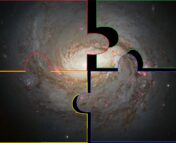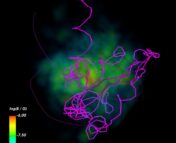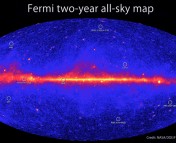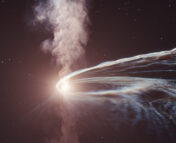Authors: E. Peretti, A. Lamastra, F. G. Saturni, M. Ahlers, P. Blasi, G. Morlino and P. Cristofari
First Author’s Institution: Niels Bohr International Academy, Niels Bohr Institute, University of Copenhagen, Copenhagen, Denmark
Status: ArXiv open access
A UFO? From outer space?
When we hear the acronym UFO, we immediately think of Unidentified Flying Objects, aliens from space come to make contact with us on Earth! But this acronym has another meaning in high-energy astrophysics – Ultra-Fast Outflows, which are relativistic winds from an Active Galactic Nucleus (AGN), a supermassive black hole at the center of a galaxy that actively eats material from around it.
AGNs are, as their name suggests, highly active – they have emissions in photons across the electromagnetic spectrum, and two have even been observed in neutrinos (TXS 0506+056, and NGC 1068). Many of them have a relativistic jet, which spews out particles from the black hole at extremely high speeds in a very narrow beam (this type of AGN where we can see the jet is called a blazar). These relativistic jets can accelerate particles to near the speed of light, and produce gamma-rays at very high energies. These charged particles are called cosmic rays.
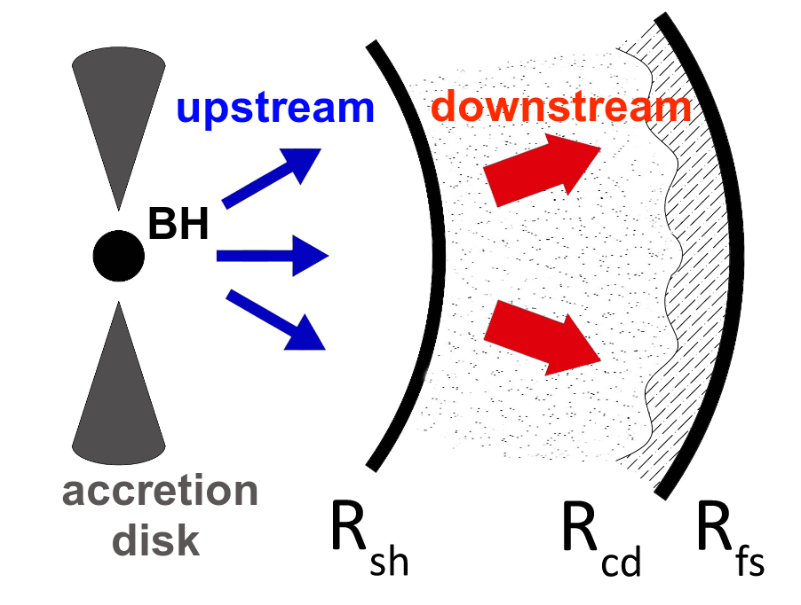
However, some AGN have another type of outflow – the Ultra-fast Outflow, or UFO. This type of outflow is not as beamed, but can accelerate particles in a wider region, to speeds that are 10-30% of the speed of light. By looking at these objects, we can decipher how particles are interacting in these outflows.
Recently, astrophysicists have been able to find gamma-rays coming from some nearby AGNs with UFOs [1]. This means that these UFO sources are accelerating particles (called cosmic rays) to ultra-high energies, and some of these particles are interacting with each other or nearby photons which we could observe via gamma rays and neutrinos. This makes UFOs interesting for multi-messenger astronomy – they could be a source of 3 different messengers: gamma-rays, cosmic rays, and neutrinos! In this paper, the authors look at the mechanisms that could allow them to accelerate particles to high energies, and compare their model to the observed gamma-rays from some of these objects.
What do we see from UFOs?
Figure 2 shows the spectrum derived in this model for a UFO, in gamma rays and neutrinos. They show the observed gamma rays (from [1]) in black points and the gray uncertainty band. Then they show the model curves from this paper in solid blue colors. The thick solid blue line shows the benchmark values used, and the thinner solid curves show some variations in parameters within their model.
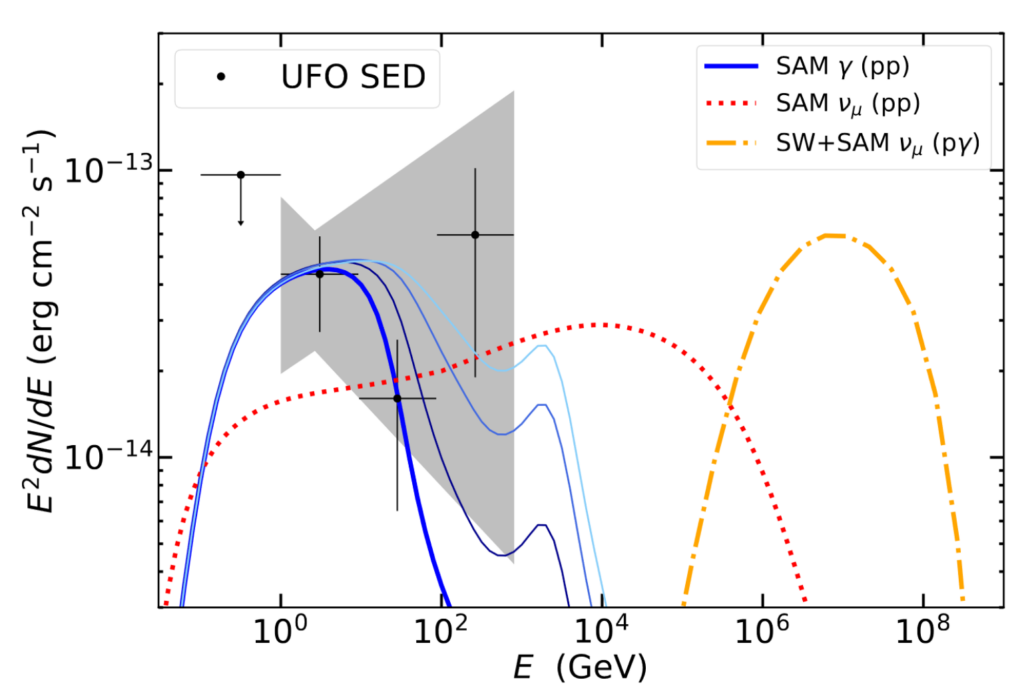
The model also predicts a flux that can be seen in neutrinos for a UFO source. There are two mechanisms that would give neutrinos, with different energy ranges depending on the interaction, which are (1) when ultra-high-energy cosmic rays interact with each other (shown in dotted red), and (2) when the ultra-high-energy cosmic rays interact with nearby photons (shown in dash-dotted orange).
The case of NGC 1068
The authors also discuss the implications of this model for NGC 1068, which is an AGN with evidence for neutrino emission from the IceCube Neutrino Observatory. NGC 1068 might have UFOs in the core of its AGN, so the authors apply their model to this AGN to see if UFOs could explain some of the neutrino flux seen from it.
The largest contributions to the flux expected from this model are from interactions between ultra-high-energy cosmic rays interacting with each other in the medium (blue solid line for gamma rays, and red dotted line for neutrinos). The flux observed in gamma rays is consistent with the model expectations.
However, in neutrinos, the model can’t explain the full flux observed by IceCube, but rather only 10% or less of the flux. This means that there must be other processes happening around the AGN to produce the neutrinos that have been observed.

Towards a clearer picture of UFOs!
These authors show that UFOs are an interesting multimessenger source – they could be accelerating cosmic rays to ultra-high energies, which would produce gamma rays and neutrinos from interactions of these cosmic rays. UFOs could also help to explain some of the diffuse multi-messenger fluxes that have been observed in cosmic rays, gamma rays, and neutrinos coming from outside our galaxy!
[1] M. Ajello et al 2021 ApJ 921 144
Disclaimer: The author of this Astrobite works with M. Ahlers, but was not involved in this research.
Astrobite edited by Lindsay DeMarchi
Featured image credit: Edited from Dark Energy Survey/DOE/FNAL/DECam/CTIO/NOIRLab/NSF/AURA Image processing: T.A. Rector (University of Alaska Anchorage/NSF’s NOIRLab), J. Miller (Gemini Observatory/NSF’s NOIRLab), M. Zamani & D. de Martin (NSF’s NOIRLab), CC BY 4.0, via Wikimedia Commons and David S. Soriano, CC BY-SA 4.0, via Wikimedia Commons

